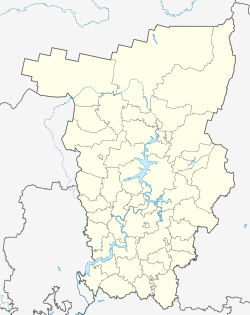Gubacha
| city
Gubacha
Губаха
|
||||||||||||||||||||||||||||||||||||||||
|
||||||||||||||||||||||||||||||||||||||||
|
||||||||||||||||||||||||||||||||||||||||
| List of cities in Russia | ||||||||||||||||||||||||||||||||||||||||
Gubacha ( Russian Губаха ) is a city in the Perm region ( Russia ) with 28,111 inhabitants (as of October 14, 2010).
geography
The city is located on the western flank of the Middle Urals about 150 km northeast of the regional capital Perm on the Koswa , a left tributary of the Kama .
Gubacha is administratively directly subordinate to the region. The city is subordinate to the urban-type settlements Ugleuralski (9310 inhabitants) and Schirokowski (1680 inhabitants) as well as 6 villages with a total of 1680 inhabitants, so that the total population of the administrative unit city of Gubacha is 39,275 (2009 calculation).
The city is on the Chusovoy - Kisel - Solikamsk railway line .
history
Gubacha emerged in the middle of the 18th century as a mining settlement near an iron ore deposit on the river of the same name (also Gubaschka ). In 1825, hard coal was discovered near today's settlement Ugleuralski .
After 1917, one of the first thermal power plants was built here under the GOELRO plan, which still exists today under the name Kiselowskaja GRES-3 , with an attached workers' settlement Krschischanowsk (also Nizhnyaya Gubacha ).
In 1928 Gubacha received urban-type settlement status . In 1936 one of the then largest coking plants in the Soviet Union went into operation.
1941 Krschischanowsk and other settlements were incorporated and the place received city rights. In November 1959 Gubacha was united with the nearby city of Ugleuralsk, which had almost as many inhabitants as Gubacha with 46,408 in the census in January 1959. The city of Gubacha, now with almost 100,000 inhabitants, was dissolved again on April 8, 1960: part of the early Ugleuralsk became an independent urban-type Ugleuralski settlement, and several other localities were spun off.
Population development
| year | Residents | comment |
|---|---|---|
| 1939 | 27,535 | of which Gubacha 14,060, Krschischanowsk (incorporated in 1941) 13,475 |
| 1959 | 47.094 | |
| 1970 | 33,243 | |
| 1979 | 32,199 | |
| 1989 | 36,858 | |
| 2002 | 31,687 | |
| 2010 | 28,111 |
Note: census data
Culture and sights
A history and local history museum has existed in Gubacha since 1967 .
economy
Coal mining experienced a decline, especially during the economic crisis of the 1990s, so that today the chemical plant of Metafraks AG is the most important company in the city. In addition, the coking plant, woodworking companies and the Kiselowskaja GRES-3 thermal power plant continue to produce .
Personalities
- Wagis Chidijatullin (born 1959), football player
- Yevgeny Ketov (* 1986), ice hockey player
- Dzmitryi Abascheu (* 1991), Belarusian biathlete
See also
Individual evidence
- ↑ a b Itogi Vserossijskoj perepisi naselenija 2010 goda. Tom 1. Čislennostʹ i razmeščenie naselenija (Results of the All-Russian Census 2010. Volume 1. Number and distribution of the population). Tables 5 , pp. 12-209; 11 , pp. 312–979 (download from the website of the Federal Service for State Statistics of the Russian Federation)
Web links
- City administration website (Russian)
- Gubacha on mojgorod.ru (Russian)


